Overview
This article delves into nine distinct leadership styles that can empower startup founders, underscoring how each approach enhances team dynamics and drives organizational success. By examining styles such as transformational, servant, and democratic, it becomes evident that selecting the appropriate leadership style can profoundly elevate team engagement, creativity, and overall performance. Such improvements are essential for effectively navigating the myriad challenges faced by startups.
Have you considered how your leadership style impacts your team's success? Understanding these styles may not only inspire you but also provide actionable insights for fostering a thriving startup environment.
Introduction
In the dynamic world of startups, the leadership style chosen by founders can determine the fine line between stagnation and success. Each leadership approach—from transformational to laissez-faire—presents unique advantages that can empower teams, drive innovation, and enhance productivity. Yet, with a plethora of options available, how can startup leaders discern which style will best align with their organizational needs and cultivate a thriving work environment? This exploration into nine distinct leadership styles not only uncovers their individual benefits but also offers strategic insights to help founders navigate the complexities of leading a startup in today's competitive landscape.
Casy: Automate Task Management for Effective Leadership
Casy operates as an invisible project manager, seamlessly integrating with platforms like Slack and Telegram. By automatically capturing key information from conversations, it transforms discussions into actionable tasks, setting deadlines and updating documents without any manual input. This level of automation empowers leaders to prioritize strategic decision-making over administrative tasks, significantly enhancing group productivity and efficiency. For startup founders, utilizing such tools alleviates the burdens of project management, allowing them to focus on innovation and growth.
Key Features:
- Automated Task Creation: Effortlessly converts chat discussions into actionable tasks, saving employees an average of 498 hours per year.
- Project Planning: Facilitates project and sprint planning with minimal setup required, aligning with the projected growth of the project management software market, expected to reach $10 billion by 2026.
- Visibility: Categorizes tasks into groups like R&D, Bugs, and In Progress, ensuring clear oversight for all participants. Communication breakdowns account for 19% of project failures, highlighting the importance of effective communication facilitated by Casy.
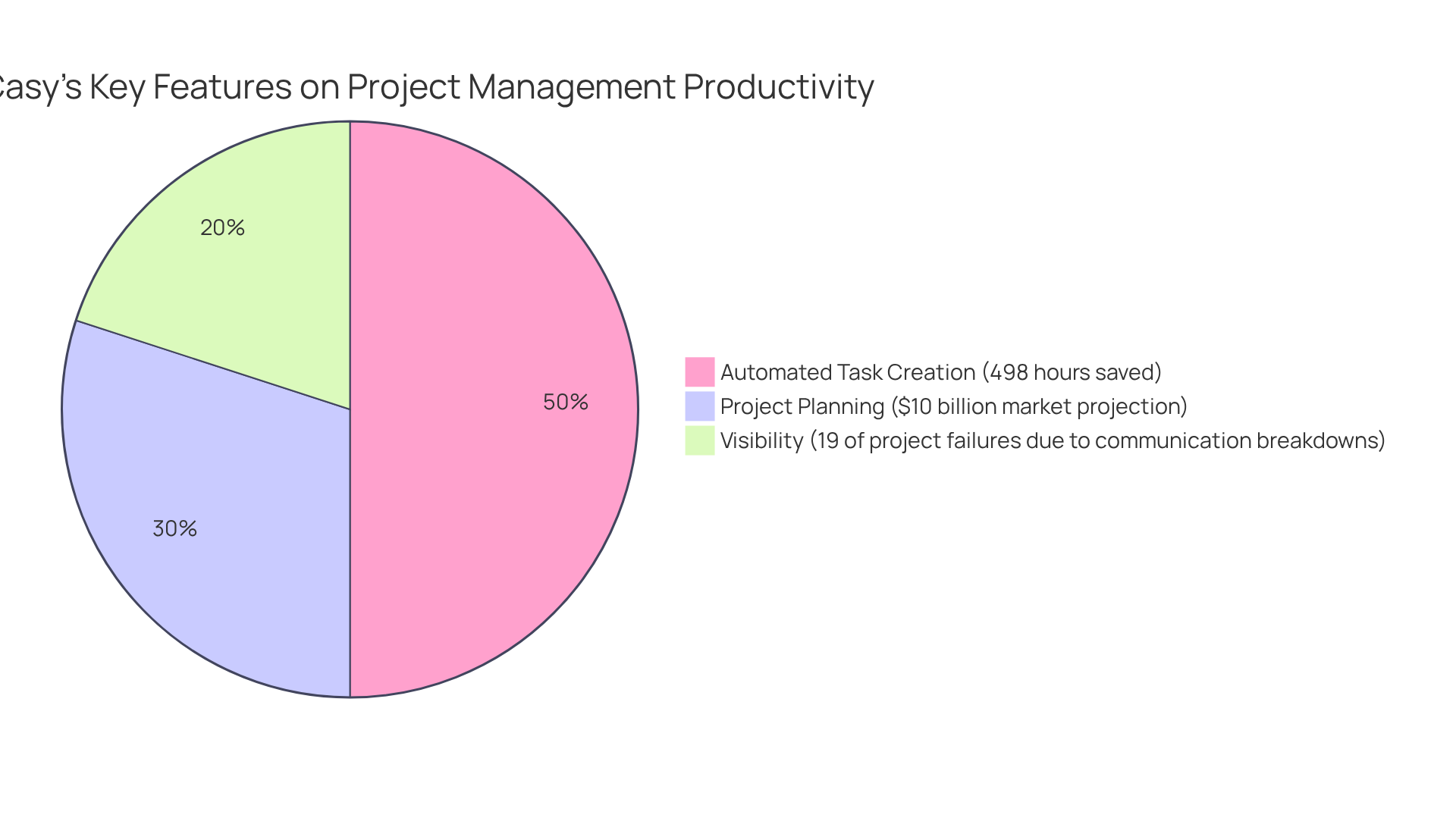
Transformational Leadership: Inspire and Innovate
Transformational leadership is characterized by the ability to inspire and motivate individuals to embrace change and pursue innovation. Leaders who adopt this style create a compelling vision for the future, galvanizing their teams to strive for excellence. This approach proves particularly effective in startups, where adaptability and creativity are paramount for navigating challenges and seizing opportunities.
-
Visionary Thinking: Transformational leaders articulate a clear and inspiring vision that aligns with their organization's goals, motivating team members to work towards a unified purpose.
-
Empowerment: They empower individuals to take ownership of their roles, fostering a sense of responsibility and commitment that enhances overall performance.
-
Supportive Environment: By cultivating a culture of collaboration and open communication, transformational leaders create an environment where team members feel secure to share ideas and experiment without fear of failure. This supportive atmosphere not only encourages creativity but also drives engagement; employees are more likely to contribute innovative solutions when they feel valued.
Looking ahead to 2025, startup executives can further inspire innovation by actively mentoring their teams, celebrating 'intrapreneurs' who drive change within the organization, and creating structured opportunities for brainstorming and idea-sharing. Initiatives such as hosting an 'Innovation Hour' or 'Failure Friday' can reframe challenges as opportunities. Moreover, employing techniques such as visualization allows leaders to assist their teams in envisioning a successful future and outlining the necessary steps to achieve it. This comprehensive approach to transformational guidance not only enhances team dynamics but also positions startups for sustained success in a rapidly changing environment.
Organizations that foster creative environments, where every opinion is acknowledged, achieve 5.5 times the revenue growth compared to less creative firms. This statistic underscores the financial advantages of adopting these managerial practices.
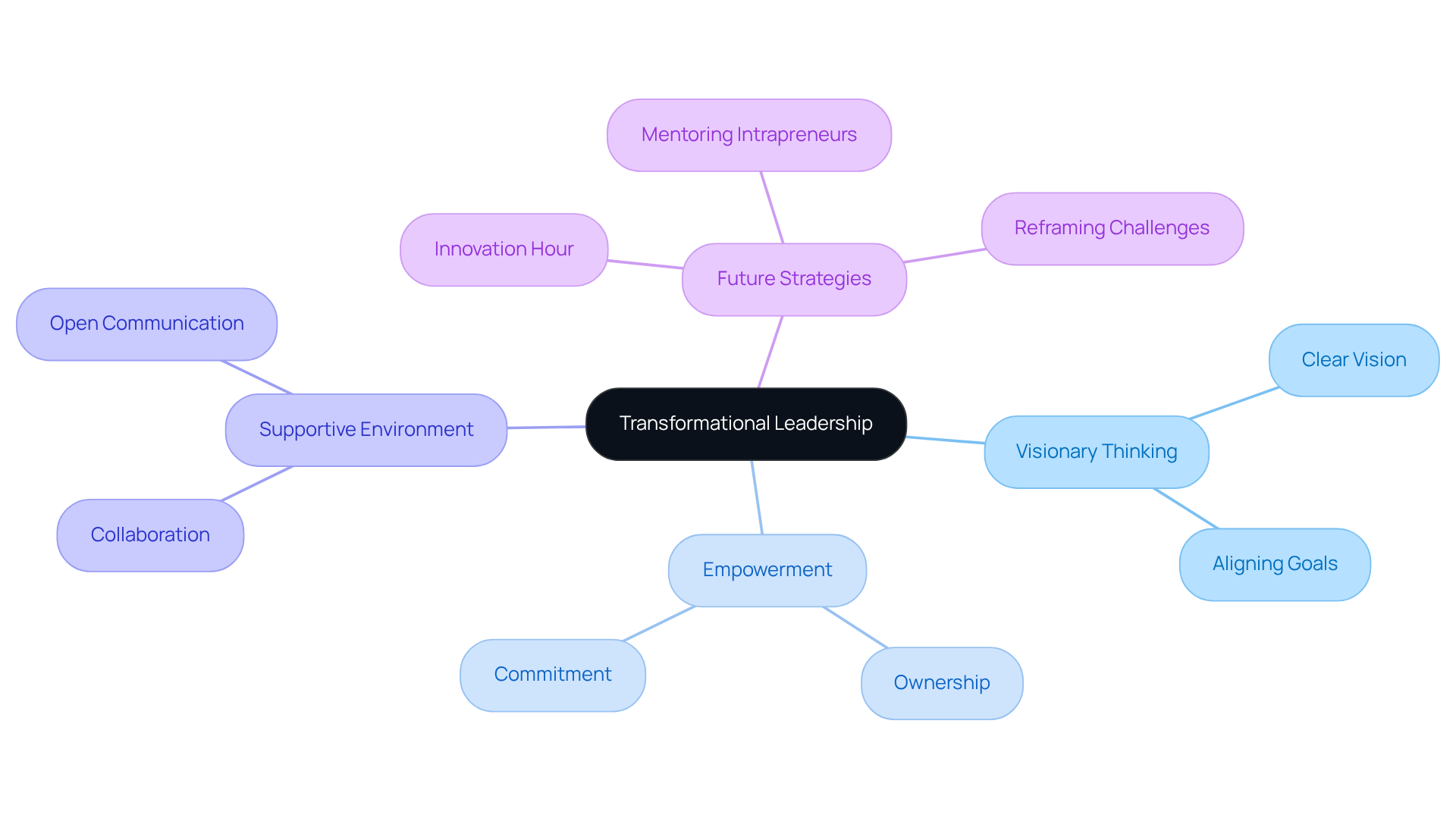
Servant Leadership: Empower Your Team
Servant leadership represents a management philosophy centered on an individual's commitment to uplifting their group. This approach prioritizes active listening, empathy, and individual growth, cultivating an environment where team members feel valued and inspired to perform at their highest level.
-
Active Listening: Servant leaders focus on grasping their team members' perspectives, thereby fostering respect and trust. This practice enhances communication and motivates individuals to share their ideas and concerns, leading to more innovative solutions.
-
Empowerment: By motivating team members to take initiative and make decisions, servant leaders instill a sense of ownership and accountability. This empowerment is increasingly vital in 2025, as organizations recognize that engaged employees drive superior business outcomes. Research shows that companies embracing servant principles experience significant improvements in employee retention and satisfaction. Notably, applying the servant approach has resulted in a 30% increase in overall productivity within just six months.
-
Community Building: Servant leaders emphasize creating a sense of belonging and collaboration within their teams. This community-oriented strategy not only boosts morale but also nurtures a culture of shared goals and collective success. Organizations adopting a servant approach report elevated levels of trust and engagement among employees, which are crucial for sustainable growth. As Mary Barra, CEO of General Motors, underscores, collaboration and open communication are essential for empowering employees.
Current trends reveal that startup founders are increasingly adopting a servant approach to navigate the complexities of today's business landscape. By prioritizing the needs of their teams, these leaders are enhancing productivity and preparing their organizations for future challenges. Real-world examples, such as the achievements of Zappos and Southwest Airlines, demonstrate how different leadership styles, especially a servant approach, can yield superior performance compared to traditional management styles. In these cases, leaders who embody servant principles have fostered environments where individuals thrive, ultimately driving innovation and organizational success. To further implement servant guidance, founders should contemplate developing mentorship programs and training initiatives that promote these principles.
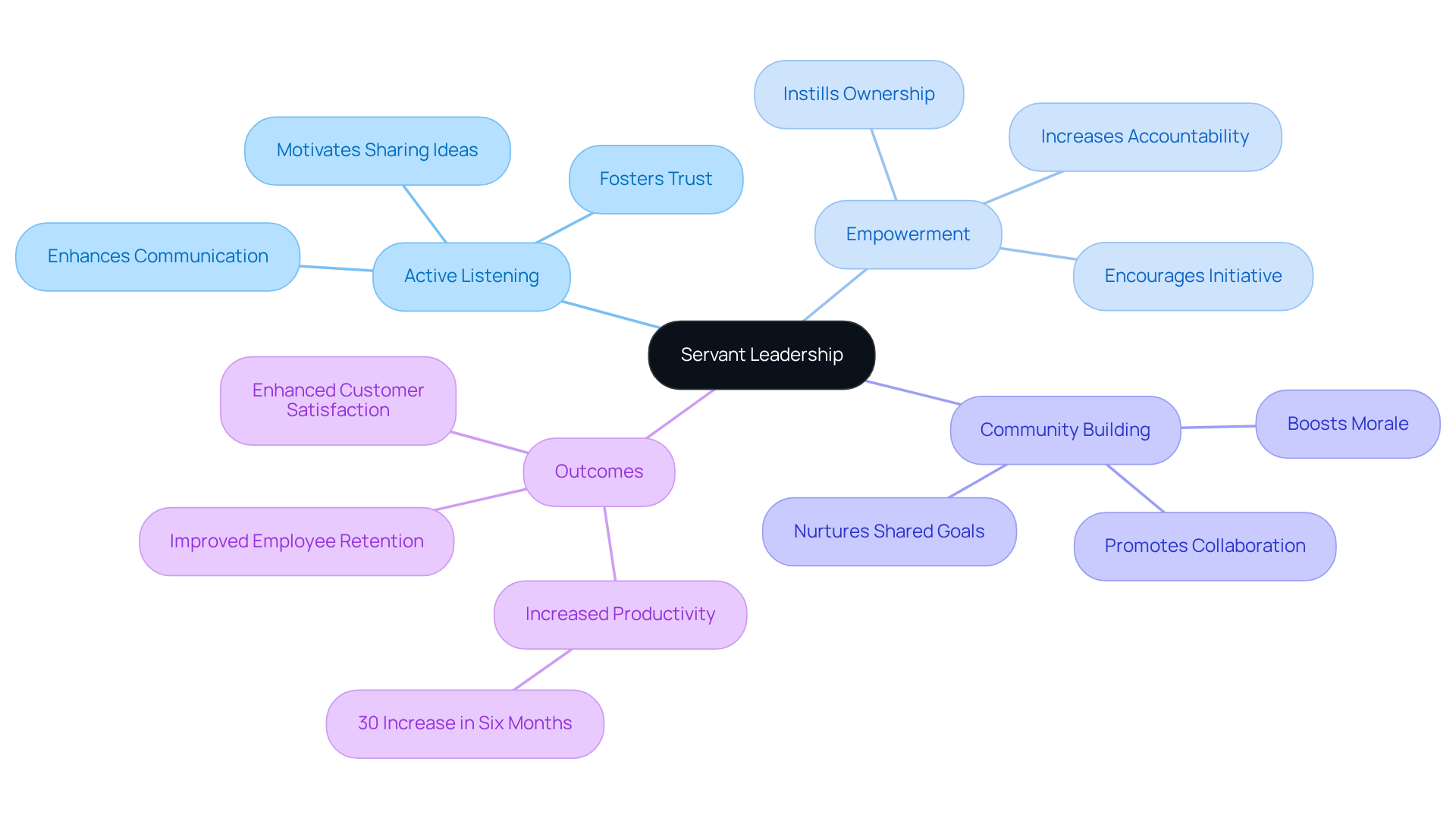
Democratic Leadership: Foster Team Participation
Democratic guidance actively involves participants in the decision-making process, cultivating a culture of cooperation and shared responsibility. This management approach not only values diverse perspectives but also encourages open dialogue, leading to more innovative solutions and heightened group morale.
Key Benefits:
- Increased Engagement: Team members feel more invested in outcomes.
- Enhanced Creativity: Diverse ideas lead to innovative solutions.
- Stronger Team Cohesion: Collaboration fosters a sense of unity and purpose.
By embracing democratic guidance, organizations can harness the full potential of their teams. Are you ready to elevate your team's engagement and creativity? Consider the transformative power of inclusive decision-making.
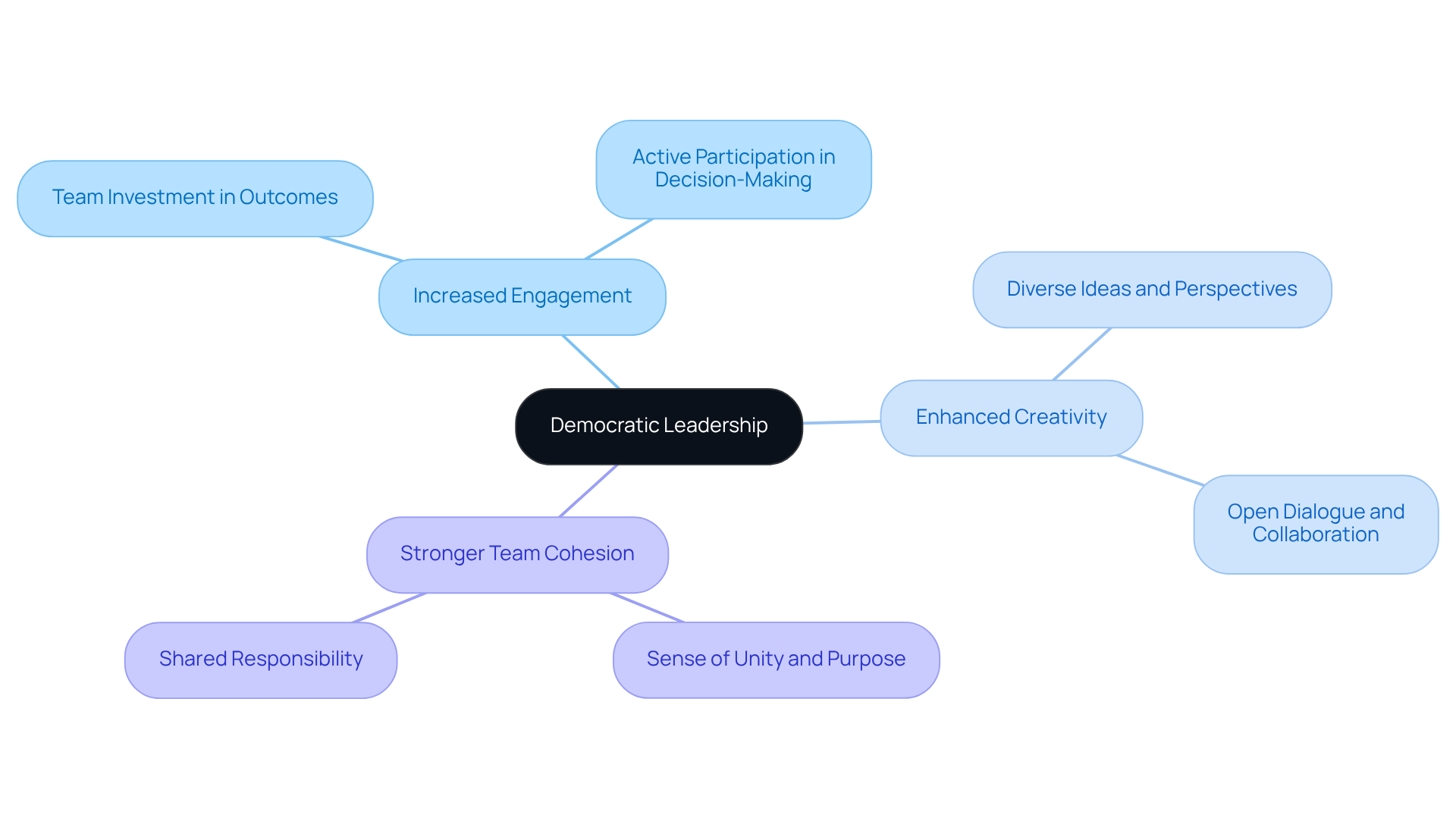
Situational Leadership: Adapt to Team Needs
Situational leadership represents a dynamic approach that empowers leaders to adjust their different leadership styles according to the unique needs of their group and the specific context at hand. This flexibility is essential in the fast-paced realm of startups, where challenges and group dynamics can shift rapidly, particularly in light of current economic instability and resource scarcity.
Assess Team Readiness: Begin by evaluating the skills and confidence levels of your team members. Understanding their abilities enables you to identify the most effective guidance strategy.
- Tailor your approach by adapting to different leadership styles to fit the situation.
- Whether it requires directing, coaching, supporting, or delegating, aligning your approach with group needs fosters a more productive environment.
- As Brent Hafele pointed out, "Leadership is about vision and responsibility, not power," underscoring the importance of adjusting to group dynamics.
Continuous Feedback: Establish open lines of communication to regularly assess group needs. This ongoing conversation allows you to make prompt adjustments to your leadership approach, ensuring that you remain responsive to your group's evolving dynamics.
- For instance, during periods of rapid growth, a hands-on method may initially be necessary to guide less experienced group members.
- However, as the group matures, transitioning to a more delegative style can empower individuals, fostering ownership and accountability.
Current trends among startup founders highlight the significance of different leadership styles, especially in navigating the complexities of resource scarcity and economic instability. Leaders who adopt this flexible model not only enhance group engagement but also prepare their organizations for enduring success in a constantly evolving environment.
- As Melissa DiMuro stated, "By embracing flexible servant guiding models, you and your organization can thrive in the evolving work environment."
- Furthermore, tools such as Casy can assist leaders in adjusting their styles and managing groups efficiently, minimizing administrative burdens and increasing productivity.
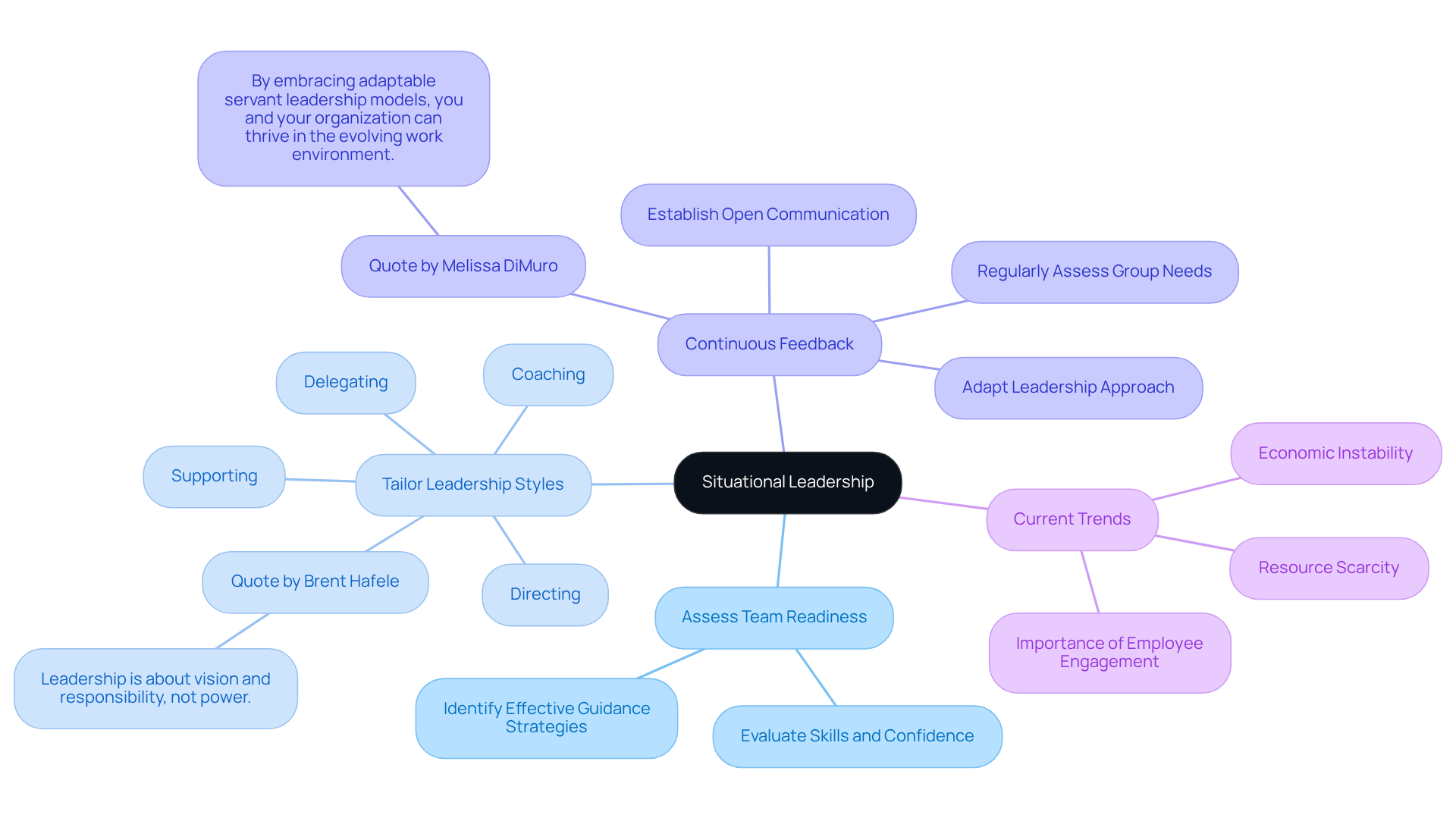
Transactional Leadership: Establish Structure and Accountability
Transactional management is defined by its emphasis on clear structures, delineated roles, and the strategic use of rewards and punishments to motivate participants. This leadership approach thrives in environments where tasks are standardized and efficiency is paramount, making it particularly relevant for startups aiming to foster accountability among their members in 2025.
-
Clear Expectations: Leaders must articulate specific goals and performance standards, ensuring that every team member comprehends their responsibilities. This clarity cultivates a sense of ownership and commitment among employees.
-
Performance Monitoring: Regular evaluations of team members' progress are crucial. By providing consistent feedback, leaders can guide their groups toward achieving established objectives, reinforcing a culture of accountability.
-
Reward Systems: Implementing incentives for meeting or surpassing expectations can significantly boost motivation. Recognizing and rewarding high performance not only elevates morale but also nurtures a competitive spirit within the group.
Current trends in different leadership styles among startups reveal an increasing acknowledgment of the effectiveness of transactional leadership in managing routine tasks. Leaders are progressively adopting different leadership styles to streamline operations and enhance productivity. For instance, organizations that prioritize accountability training report heightened engagement and trust among members, leading to elevated performance levels.
Examples of performance monitoring in teams include establishing regular check-ins and utilizing project management tools to track progress. These practices are instrumental in assessing individual contributions while also pinpointing areas for improvement.
Establishing clear expectations is vital in transactional management. Leaders should articulate what success entails for each role and communicate these standards effectively. This strategy not only clarifies responsibilities but also empowers employees to take ownership of their work, ultimately propelling the organization toward its goals.
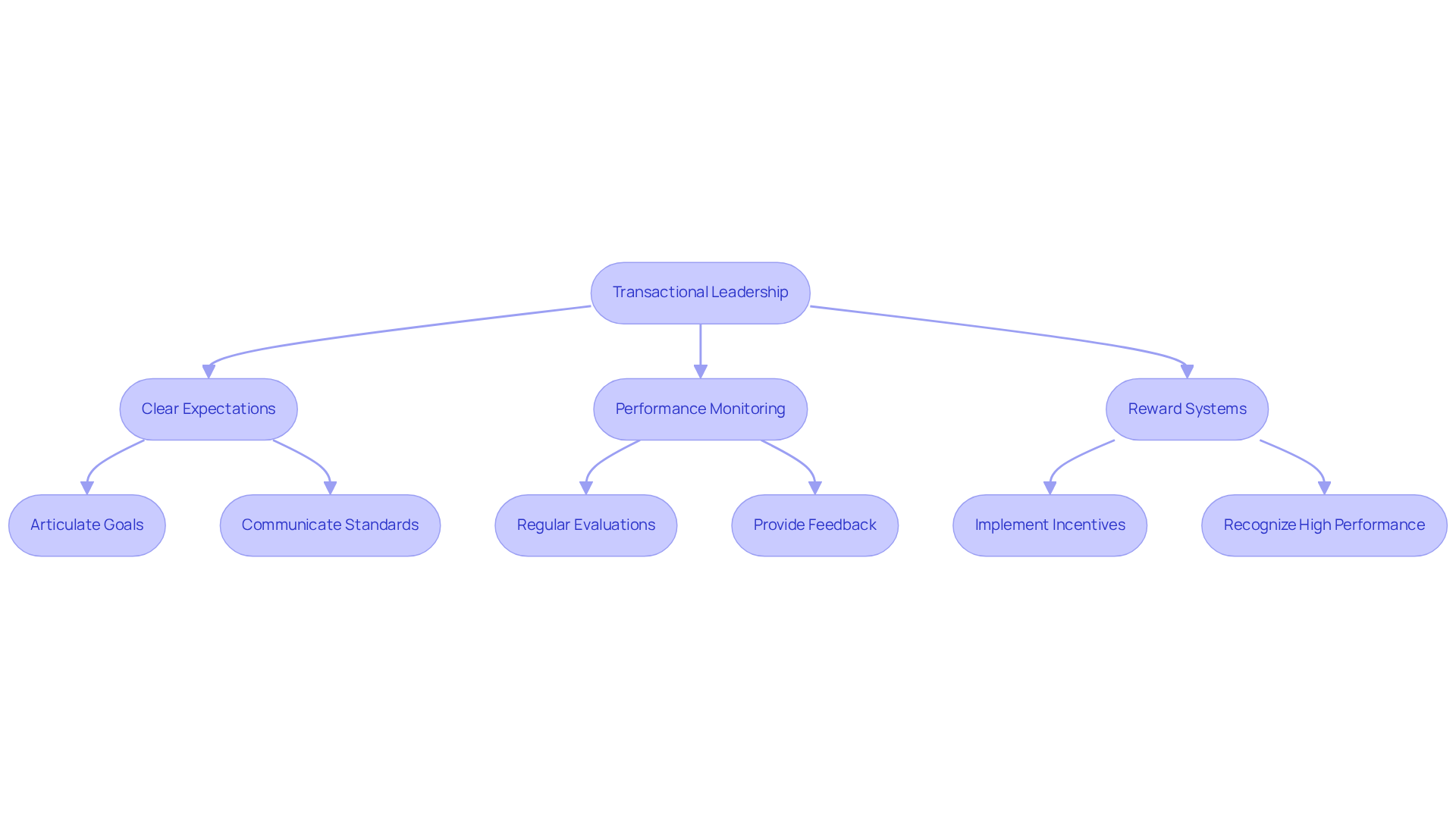
Autocratic Leadership: Make Quick Decisions When Necessary
Autocratic guidance is characterized by a single individual making decisions with minimal to no input from colleagues. This approach proves particularly effective in scenarios demanding swift decision-making, such as during crises or when immediate action is necessary.
Key Advantages:
- Speed: Decisions are rendered rapidly, eliminating the need for prolonged discussions.
- Clarity: Clear directives are provided, reducing uncertainty for staff.
- Control: Leaders maintain stringent oversight over processes and outcomes.
In a world where time is of the essence, understanding the implications of autocratic guidance can be crucial. How often do you find yourself needing to make quick decisions? Recognizing the benefits of this style can empower leaders to take decisive action when it matters most.
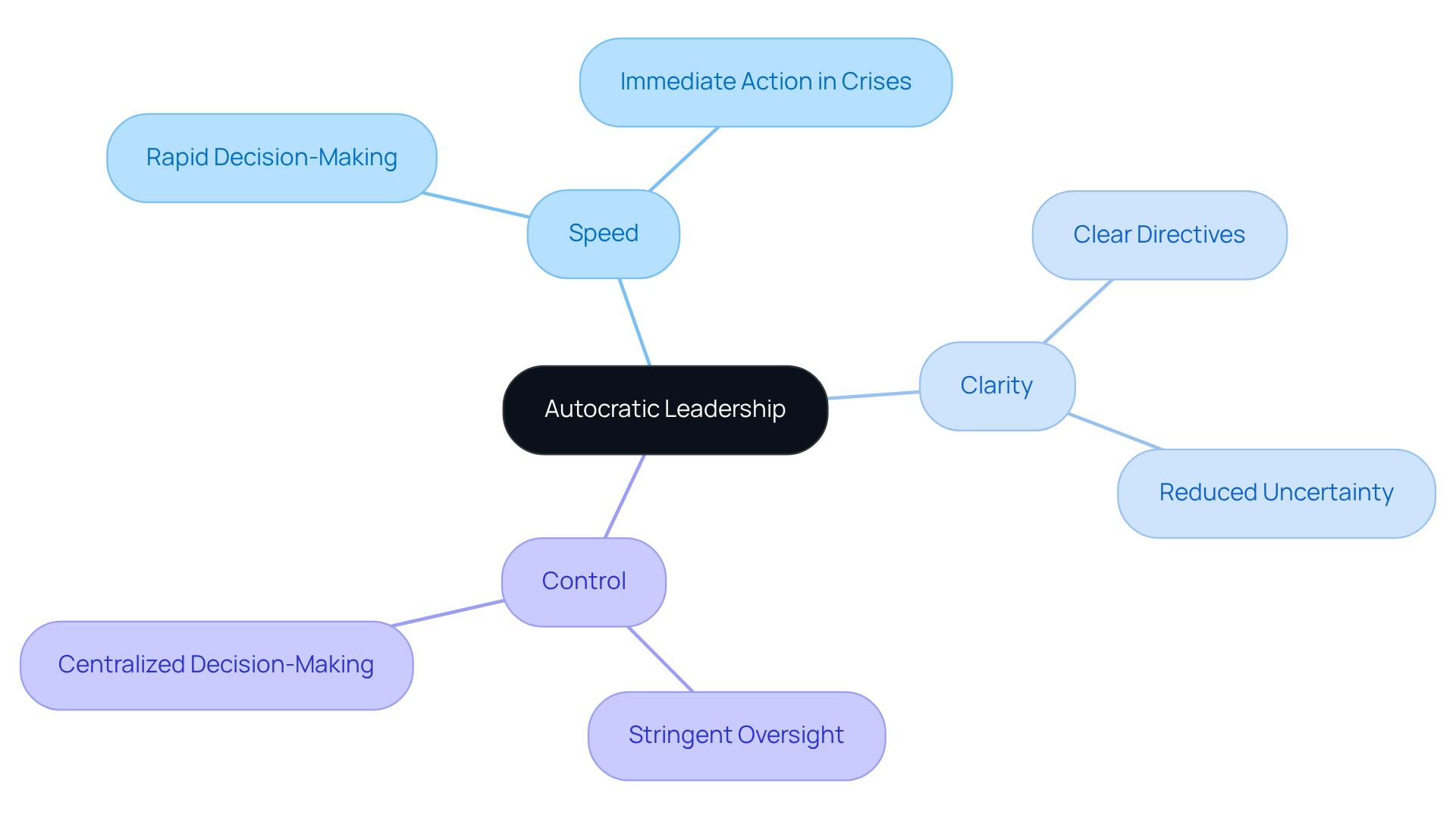
Coaching Leadership: Develop Your Team's Skills
Coaching leadership is pivotal in developing individuals through guidance, support, and constructive feedback. Leaders who adopt this approach prioritize individual growth, fostering a culture of continuous improvement essential in today's dynamic work environment.
Personalized Development Plans: Tailoring development plans for each team member is crucial. These plans should focus on enhancing specific skills and competencies, aligning individual goals with organizational objectives. For instance, startups can implement mentorship programs that pair high-potential employees with experienced leaders, facilitating skill transfer and optimization.
Regular Feedback: Offering ongoing and helpful feedback is essential for directing individuals toward enhancement. Did you know that organizations offering coaching experience 32% higher employee engagement and retention rates? This statistic underscores the importance of feedback in fostering a motivated workforce. Furthermore, 70% of executives who have worked with a coach report improved work performance and leadership effectiveness, highlighting the tangible benefits of coaching.
Promote Self-Reflection: Establishing a setting that promotes self-reflection enables members to evaluate their performance and recognize areas for improvement. This practice not only enhances individual accountability but also contributes to overall team effectiveness.
As we approach 2025, organizations will confront a management crisis—with nearly 60% of workers contemplating new job opportunities due to inadequate administration. Implementing personalized development plans and feedback mechanisms will be essential for retaining talent and driving business success. By investing in these coaching practices, startups can cultivate leaders who not only excel in their roles but also inspire others to reach their full potential. Moreover, with the executive coaching sector expanding at an annual rate of 6.7% since 2015, the acknowledgment of coaching's significance in management development is more relevant than ever.
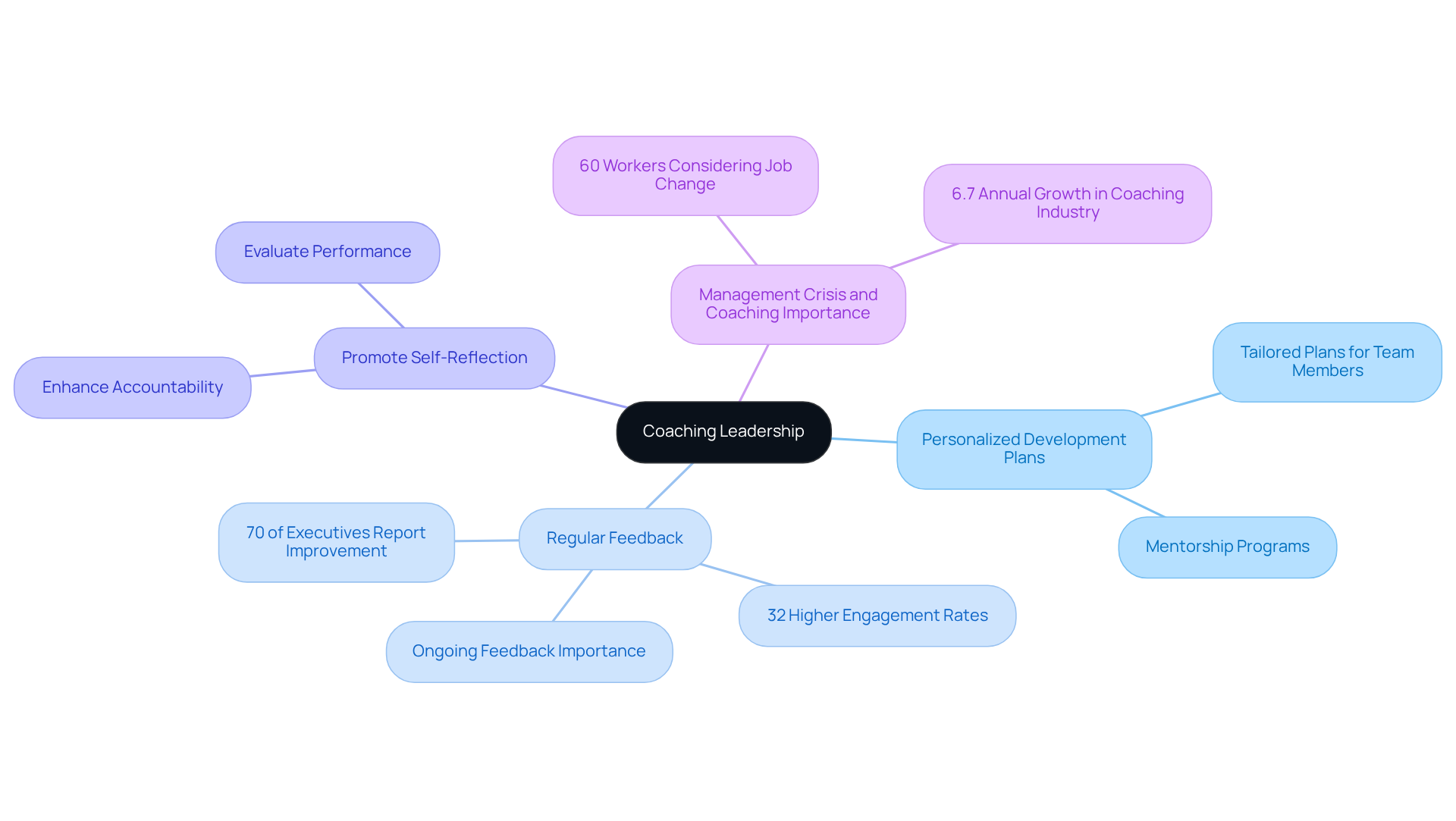
Pacesetting Leadership: Drive High Performance
Pacesetting leadership, along with different leadership styles, is defined by its high performance standards and the practice of leading by example. Leaders who embrace this approach not only set ambitious goals for themselves but also expect their team members to rise to these challenges. They actively collaborate with their teams to achieve outstanding results, fostering a culture of excellence.
Key characteristics of pacesetting leadership include:
- High Expectations: Leaders set ambitious goals for themselves and their teams, pushing the boundaries of what is possible.
- Lead by Example: They embody the work ethic and behaviors they wish to see in others, serving as a model for their teams.
- Focus on Results: Pacesetting individuals emphasize the importance of achieving outcomes swiftly and efficiently, driving their teams toward success.
This leadership style not only inspires teams to meet high standards but also cultivates an environment where different leadership styles make excellence the norm. How can you implement these principles in your own leadership approach? Consider the impact of setting clear expectations and leading by example in your organization.
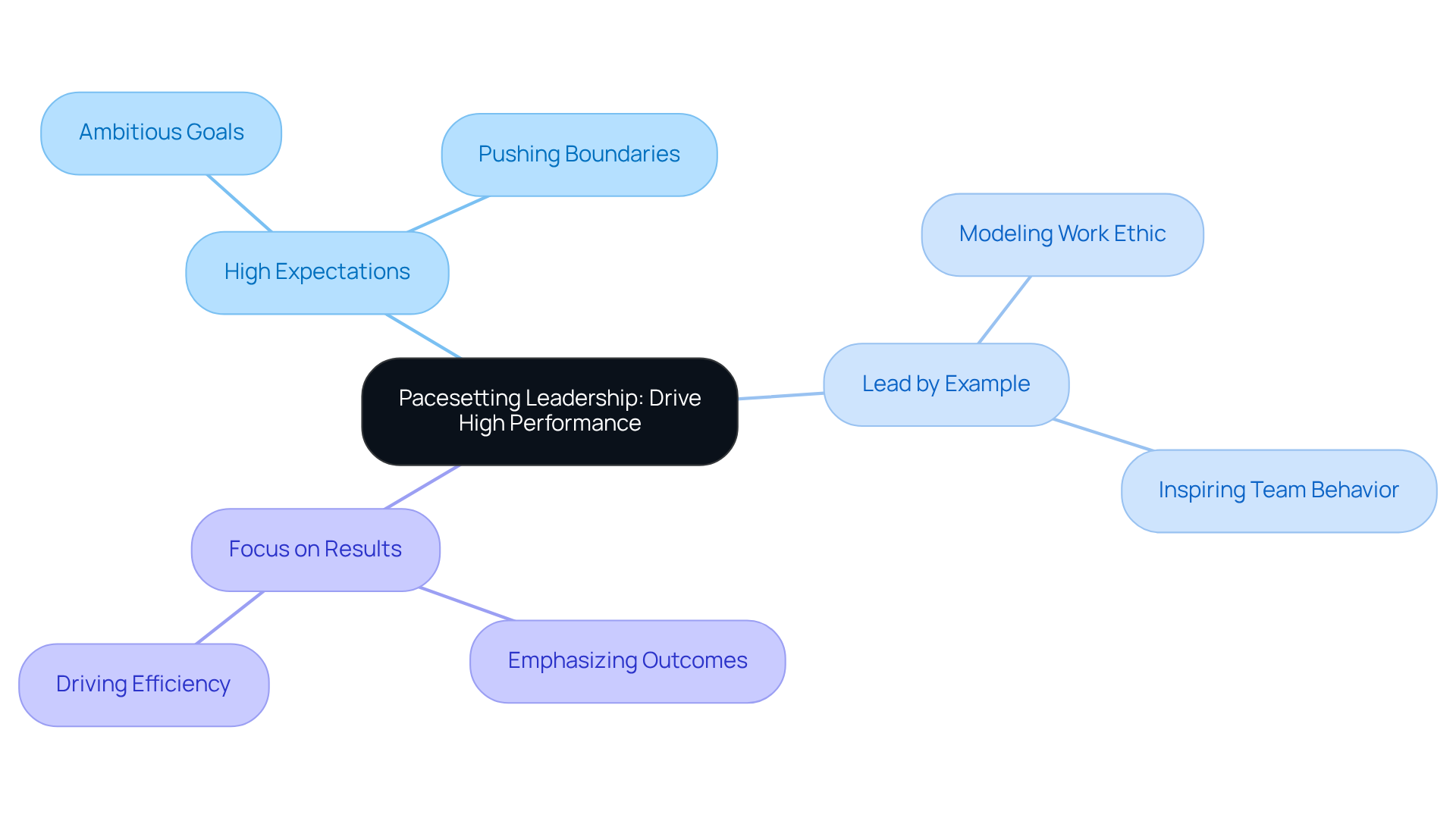
Laissez-Faire Leadership: Foster Autonomy and Innovation
Laissez-faire guidance is an example of different leadership styles, embodying a hands-off approach where supervisors provide minimal direction, enabling individuals to make their own choices. This management style is particularly effective in fostering independence and stimulating creativity, showcasing how different leadership styles can be ideal for inventive groups.
- Empowerment: By granting group members the freedom to explore their ideas and approaches, laissez-faire leadership cultivates a sense of ownership and responsibility. As John Quincy Adams stated, "If your actions inspire others to dream more, learn more, do more and become more, you are a leader."
- Creativity: The absence of micromanagement often leads to heightened innovation, as individuals feel liberated to think outside the box and experiment with new concepts.
- Ownership: When employees are entrusted with their work, they experience greater job satisfaction, translating into increased productivity and dedication to the group's objectives.
In 2025, promoting independence in startup settings through hands-off management can significantly enhance group dynamics, creating an atmosphere where innovation flourishes. However, it is essential to consider potential criticisms of different leadership styles in this approach. John Maynard Keynes critiques laissez-faire for its theoretical inadequacies, while Thomas Carlyle warns against promoting greed and despair. To implement laissez-faire leadership effectively, startup founders must focus on creating an environment that encourages open communication and trust, ensuring that team members feel supported while pursuing their creative endeavors.
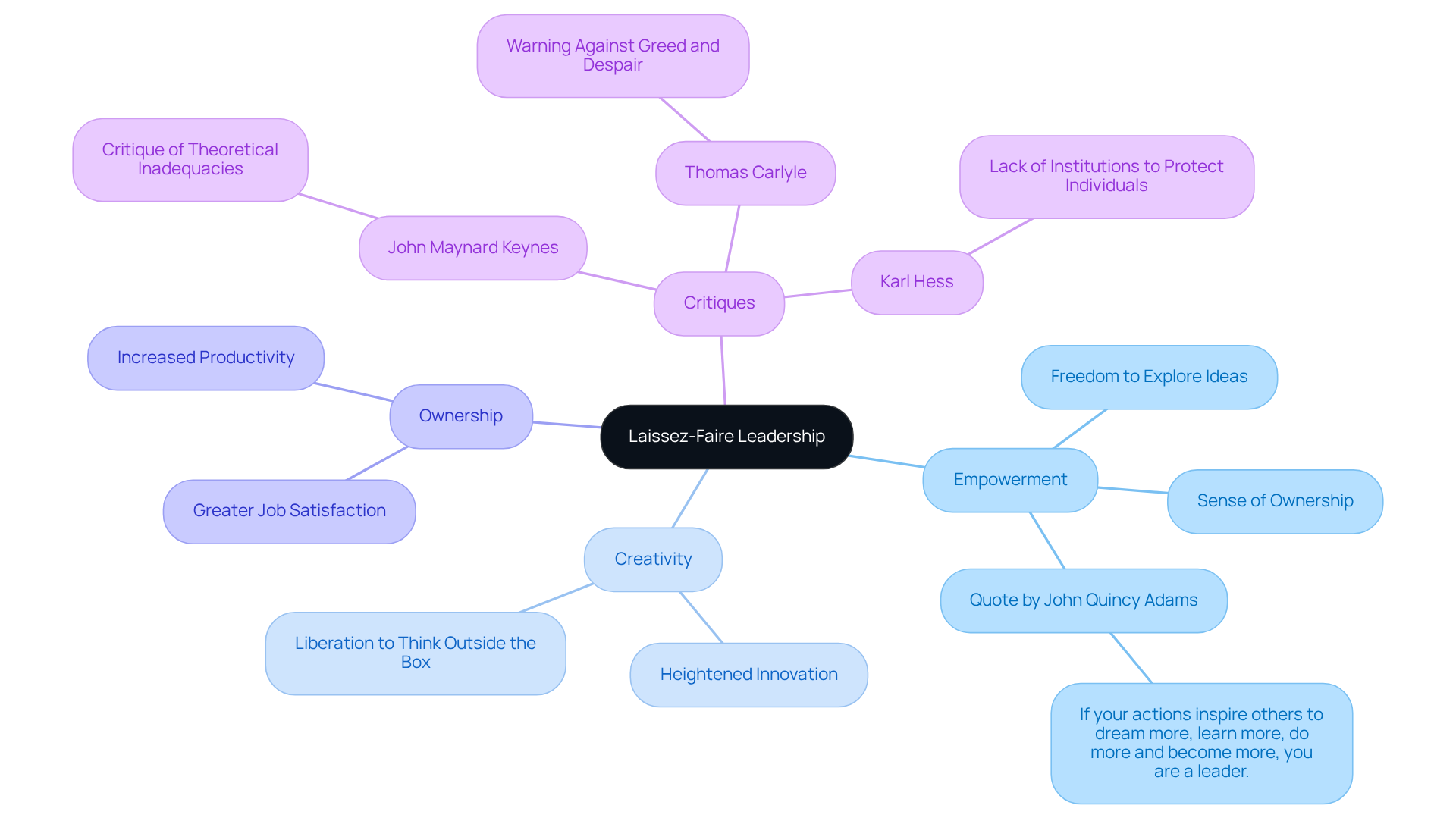
Conclusion
Understanding the various leadership styles available to startup founders is crucial for fostering an environment that promotes growth, innovation, and team engagement. By mastering different approaches—ranging from transformational and servant leadership to democratic and situational styles—leaders can effectively navigate the complexities of their organizations. Each style offers unique benefits that cater to specific challenges, empowering founders to adapt and thrive in a competitive landscape.
Key insights from the article highlight how tools like Casy can streamline task management, allowing leaders to focus on strategic decision-making rather than administrative burdens. Transformational leadership inspires teams to embrace change, while servant leadership prioritizes the well-being and development of individual team members. Democratic leadership encourages participation; situational leadership adapts to varying circumstances, and transactional leadership establishes clear expectations and accountability. Furthermore, pacesetting and laissez-faire styles foster high performance and innovation, respectively, demonstrating the versatility required in today's dynamic business environment.
In conclusion, the impact of effective leadership styles on startup success cannot be overstated. By embracing a blend of these approaches, founders can cultivate a motivated and engaged workforce capable of driving their vision forward. As the business landscape continues to evolve, the ability to adapt leadership styles to meet both team needs and organizational goals will be essential for achieving lasting success. Taking action to implement these strategies not only enhances team dynamics but also positions startups to seize opportunities and overcome challenges in an ever-changing world.
Frequently Asked Questions
What is Casy and how does it assist in task management?
Casy is an automated project management tool that integrates with platforms like Slack and Telegram. It captures key information from conversations, converting them into actionable tasks, setting deadlines, and updating documents automatically, which enhances productivity and allows leaders to focus on strategic decision-making.
What are the key features of Casy?
Key features of Casy include automated task creation that saves employees an average of 498 hours per year, project planning with minimal setup, and visibility by categorizing tasks into groups such as R&D, Bugs, and In Progress to ensure clear oversight.
How does transformational leadership benefit organizations?
Transformational leadership inspires and motivates individuals to embrace change and innovation, creating a compelling vision for the future. This leadership style is particularly effective in startups, fostering adaptability and creativity to navigate challenges and seize opportunities.
What are the main characteristics of transformational leaders?
Transformational leaders are characterized by visionary thinking, empowerment of team members, and the creation of a supportive environment that encourages collaboration, open communication, and the sharing of ideas without fear of failure.
How can startup executives inspire innovation in their teams?
Startup executives can inspire innovation by mentoring their teams, celebrating 'intrapreneurs', creating structured opportunities for brainstorming, and employing techniques such as visualization to help teams envision a successful future.
What is servant leadership and its core principles?
Servant leadership is a management philosophy focused on uplifting the team. Its core principles include active listening, empowerment of team members, and community building, which fosters an environment where individuals feel valued and inspired to perform at their best.
How does servant leadership impact employee engagement and productivity?
Servant leadership enhances employee engagement and satisfaction, leading to significant improvements in retention and productivity. Companies that adopt servant principles have reported up to a 30% increase in overall productivity within six months.
What trends are emerging in leadership styles among startup founders?
Startup founders are increasingly adopting a servant leadership approach to address the complexities of modern business. This style prioritizes team needs, enhances productivity, and prepares organizations for future challenges, as evidenced by successful companies like Zappos and Southwest Airlines.




